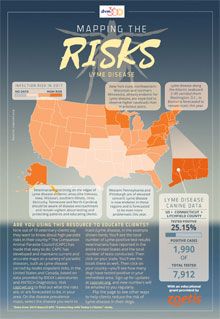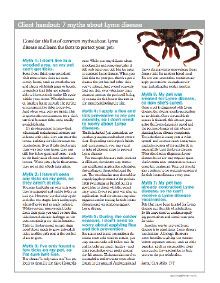Mapping the risks: Lyme disease
Use CAPC's maps and dvm360's videos, handouts, and ready-made social media posts to help your veterinary care team in your client education efforts on Lyme disease.

Click here for a downloadable PDF.Are you using this resource to educate clients?
Nine out of 10 veterinary clients say they want to know about high parasite risks in their county.* The Companion Animal Parasite Council (CAPC) has made that easy to do. CAPC has developed and maintains current and accurate maps on a variety of parasitic diseases, such as Lyme disease carried by Ixodes scapularis ticks, in the United States and Canada, based on data provided by IDEXX Laboratories and ANTECH Diagnostics.
Visit capcvet.org to find out what the risks are, or are forecasted to be, in your area. On the disease prevalence maps, select the disease you want to track (Lyme disease, in the example shown here). You'll see the total number of Lyme-positive test results veterinarians have reported in the entire United States and the total number of tests conducted.

Then click on your state. You'll see the totals there as well. Then click on your county-you'll see how many dogs have tested positive in your immediate area.

Sign up for updates at capcvet.org, and new numbers will be emailed to you regularly. Read on to explore other ways to help clients reduce the risk of Lyme disease in their dogs.

Publicizing prime Lyme time to clients
“Winter is coming. I don't need to give a tick preventive. And another vaccine? Really!?”
Have you heard this from your clients? They don't get that they have two excellent tools that can prevent Lyme disease from ever taking hold in their pets-parasite preventives and vaccines. Veterinary parasitologist Dr. Susan Little reminds us all of the never-ending risk of ticks: “Adult deer ticks, which are the primary transmitter of Lyme disease and other infections to dogs, are actually most active in the fall. Their activity peaks in October, and they'll continue to quest, or seek a host, through the winter months.” In this video from CAPC at dvm360.com/deertick, Dr. Little says as long as the ambient temperature is over 40 F, deer ticks will be on the hunt for new hosts. In fact, the risk of infection with Borrelia burgdorferi in dogs peaks in the winter!
Do you need help passing on pertinent information to your clients about Lyme disease preventives or the added protection of a vaccine? We've created Facebook and twitter posts at dvm360.com/tickposts, ripe for the taking.

Another myth to bust about Lyme disease: “I don't live in a wooded area, so my pet can't get ticks.”
When clients assert their pets don't visit areas where ticks are commonly found, such as wooded areas and places with high grass or brush, it's helpful to explain that ticks are actually able to live out their entire life cycle within the pet owner's home. It helps to mention that woodpiles near or inside a home provide the perfect environment for ticks to survive. And if there are pets inside, this improves the environment for a tick's survival because they need readily available hosts.
You also might mention that when small rodents such as mice are infested with ticks, they can enter the house, bringing the ticks indoors. Even if ticks don't make their way into the home, they can still live in low grass and trees-such as found in the backyards of most suburban homes. When pets play in these areas, they are at risk of tick infestation.
Download a client handout featuring this and 6 more myths you can bust about Lyme disease at dvm360.com/lymemyths.
*Data from the 2015 Bayer/CAPC "Connecting with Today's Clients" study.